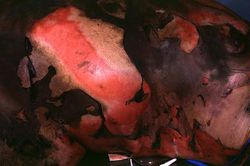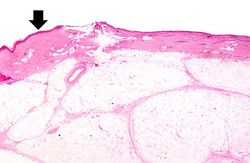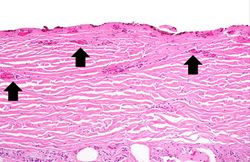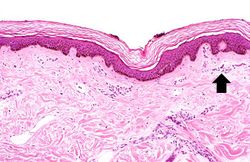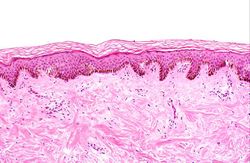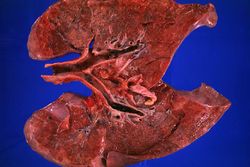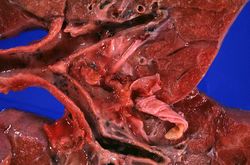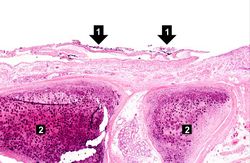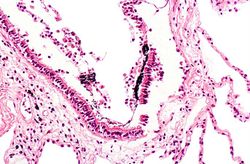Difference between revisions of "IPLab:Lab 12:Burns"
(→Study Questions) |
(→Study Questions) |
||
| Line 23: | Line 23: | ||
== Study Questions == | == Study Questions == | ||
| − | * <spoiler text="What was the immediate cause of death (COD) in this patient? What other factors played a role in this patient's demise?"> | + | * <spoiler text="What was the immediate cause of death (COD) in this patient? What other factors played a role in this patient's demise?">The immediate cause of death for this patient is thermal injury involving 80% body surface area. This large body surface area of burn injury is very severe and has a poor prognosis. The gross and microscopic evidence of smoke inhalation and burn injury to the nose, throat and lungs are indicative of severe lung injury. Inhalation injury is seen in over 80% of patients with a burn size of 85% or more of the total body surface area. Carbon monoxide poisoning also contributes to the early death in inhalation injury. The manner of death in this case would have been accidental - unless someone deliberately set the fire. |
This additional factor of the severity and the extent of the body surface area burn would likely have lead to death of this patient. Clinical management of a patient with burns this severe would be very difficult. Shock and sepsis are common problems in these patients.</spoiler> | This additional factor of the severity and the extent of the body surface area burn would likely have lead to death of this patient. Clinical management of a patient with burns this severe would be very difficult. Shock and sepsis are common problems in these patients.</spoiler> | ||
Revision as of 15:45, 20 November 2015
Contents
Clinical Summary[edit]
This 45-year-old back female was involved in a house fire which killed her husband. Upon admission to a local emergency room she was found to have approximately 80% body surface area burns including 1st, 2nd, and 3rd degree burns. Burns were most severe around the head and neck. The patient was intubated and transferred to a tertiary care center. Upon arrival, the patient had a blood pressure of 71/25 mmHg, a heart rate of 121, and was responsive to deep pain but had few spontaneous movements. Both eyes were swollen shut, her nasal hairs were singed, and carbonaceous deposits were present in her nares, throat, and posterior pharynx. Despite aggressive fluid resuscitation and ventilatory support, she remained hypotensive, and became progressively hypoxemic and hypercapnic until she died approximately eight hours after the fire.
Autopsy Findings[edit]
The degree and severity of body surface burns were documented. Carbonaceous material was noted in the throat and posterior pharynx as well as in the trachea and main stem bronchi. The liver was soft, yellow and greasy. Results of premortem blood work showed a blood alcohol level of 147 mg/dL.
Images[edit]
Study Questions[edit]
Additional Resources[edit]
Reference[edit]
- eMedicine Medical Library: Thermal Burns
- eMedicine Medical Library: Emergent Management of Thermal Burns
- Merck Manual: Burns
Journal Articles[edit]
- Fukuzuka K, Rosenberg JJ, Gaines GC, Edwards CK 3rd, Clare-Salzler M, MacKay SL, Moldawer LL, Copeland EM 3rd, Mozingo DW. Caspase-3-dependent organ apoptosis early after burn injury. Ann Surg 1999 Jun;229(6):851-8; discussion 858-9.
Images[edit]
| |||||
A blood alcohol level over 100 mg/dL is considered legally drunk.
In alcoholics, aspiration pneumonia is common--bacteria enter the lung via aspiration of gastric contents.

